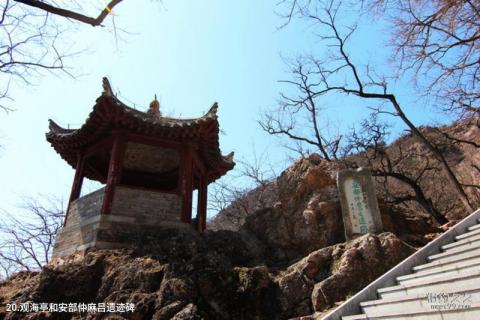
Introduction to the Guanhai Pavilion and the Anbe Nakamaru Relics Monument: There is a "Anbe Nakamaru Remains" monument under the Dagushan Sea Viewing Pavilion, which was built by Hu Ranfang, the former abbot of the Dagushan Temple, in 1934. established.
Abe Nakamaro (first known as Abe Nakamaro), a native of Yamato, was born in 701. Japanese students sent to Tang Dynasty during the Nara period. In the fourth year of Tenbao (717) of Tang Dynasty (Xuanzong), Abe Nakamaro and others, including Kibi Mabei, the father of Japanese writing who later used the radicals of Chinese characters to create katakana, came to Chang'an (today's Xi'an), the capital of the Tang Dynasty in China. ). After Anbu Zhongmalu came to Chang'an, he initially took the Han name of the court official Zhongman, and later changed it to Chao (Chao) Heng. He studied at Taixue, was good at poetry, and sang with the great poets Li Bai and Wang Weiduo. In the twelfth year of Tang Tianbao's reign (753), Anbu Zhongma Lu crossed the sea and returned eastward. He encountered a storm on the way and drifted to Annan (Vietnam). After Li Bai heard the legend that he had died, he wrote a poem "Crying for Chao Qingheng" in mourning, saying: "Japanese Chao Qing resigned from the imperial capital, and the sails were wrapped around the canopy pot; the bright moon did not return and sank into the blue sea, and the white clouds filled the sky with sadness." Later, Anbu Zhongmalu returned to Chang'an and stayed in the Tang Dynasty to serve as an official. He served as a regular servant of Zuo Sanqi and the protector of Zhennan. He died in China in the fourth year of Dali (770) of the Tang Dynasty (Dai Zong). Now in Xi'an Xingqing Palace Park, there is the "Abe Nakamaru Monument". The legendary Nakamaro Abe had two unsuccessful attempts to cross the sea and return eastward. Once, his boat capsized in the Yellow Sea and was rescued by fishermen. He had been to Dalu Island and Dagushan.
